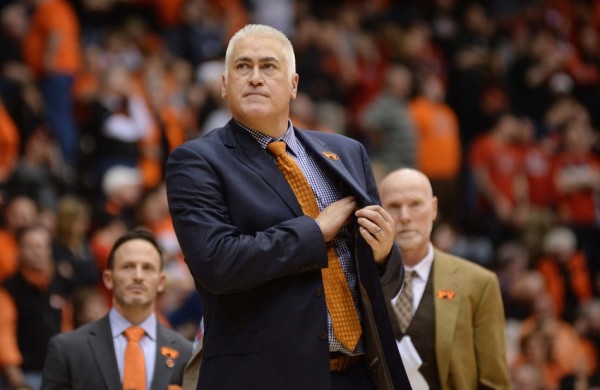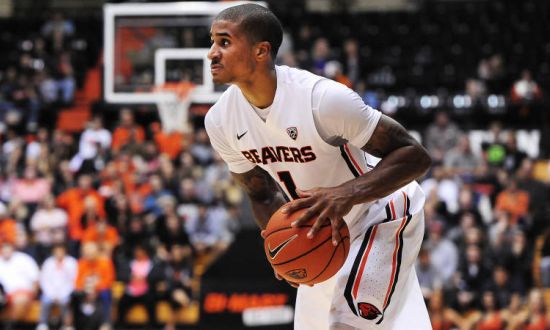Oregon State Preview: Can the Beavers Finally Break Out?
Posted by Michael Lemaire on November 6th, 2015In the next three weeks leading up to season tipoff, the Pac-12 microsite will be evaluating each of the league’s 12 teams. Today, we head to Corvallis.
Oregon State Beavers
After years of sustained mediocrity under former head coach Craig Robinson, Oregon State took a (very) small step forward in its first season under new coach Wayne Tinkle. The Beavers may have won only 17 games and still finished below .500 in the Pac-12, but they did it with a roster returning just one meaningful contributor and quickly earned a reputation as one of the toughest defensive teams in the country. After surprising plenty of observers last season with their newfound competitiveness, Tinkle’s team isn’t going to sneak up on anyone this season. His squad not only returns almost every key player but also adds four of the top 150 recruits in the country. The result of those two things should be the addition of a little firepower to what was often a punchless offense. There are still a lot of moving parts that will be Tinkle’s responsibility to clean up and fit together, but all of a sudden the Beavers have become one of the deepest and most experienced teams in the Pac-12. If the freshmen can live up to even a portion of their hype and the trademark suffocating defense doesn’t disappear, the Beavers could find themselves in the NCAA Tournament by the end of the season.
Strengths: Tinkle has always been known for his hard-nosed approach on defense, but few could have predicted that last season’s roster full of question marks would quickly evolve into one of the 20 most efficient defenses in the entire country. Some of this is a byproduct of the super-slow pace that the Beavers play, but led by reigning Pac-12 Defensive Player of the Year Gary Payton II, the Beavers harassed opposing teams into poor shooting nights, forced turnovers and protected the rim. The team allowed opponents to score 70 points or more just seven times all season, hounding opponents into shooting just 30 percent from downtown along the way. This year’s team should be at least as good defensively as it was last season. If the Beavers can keep the opposition off the free throw line — something at which they failed miserably last season — they should be even better. Also, aside from losing troubled but talented forward Victor Robbins, who was dismissed in June, Oregon State returns literally everyone who played meaningful minutes, giving Tinkle heavy doses of both depth and experience. This should allow the head coach the luxury of fitting the newcomers into places where they can succeed. Lineups can also be mixed and matched in a way that enables the Beavers to compete with both big and small teams. Bottom line: If Oregon State can maintain its defensive efficiency this season, the Beavers should be competitive in every game they play.
Weaknesses: The slowdown pace of the offense can help on the defensive end of the floor, but if the team can’t shoot and score, it can also kneecap a team’s offense. Last year was a prime example for Oregon State, as Tinkle’s team bricked its way to one of the worst offensive efficiency ratings in the country. Turnovers and poor rebounding played a large part in that lack of success, but it was the absence of accurate shooting that really grounded the team’s offense. Payton II and Malcolm Duvivier have plenty of redeemable qualities, but both made just 30 percent of the nearly 100 three-pointers each took last season. Langston Morris-Walker took 117 three-pointers last season with similar success. He also shot just 30 percent from downtown. In fact, if it wasn’t for silky forward Olaf Schaftenaar and his 37 percent success rate, the Beavers would have been historically inept from behind the three-point arc. The hope is that the freshmen, especially savvy sharpshooter Stephen Thompson Jr. and the coach’s son, Tres Tinkle, will fill some of that void. That’s an important void to have filled, because it’s hard to imagine Duvivier and Payton II becoming consistent three-point threats. The subtle weakness that cost the Beavers last year was actually on the defensive end, where opponents scored 27 percent of their points from the free throw line, the seventh-highest rate in the country. The good news is that some regression would seem to be in order on the frequency of opponents’ makes once they reach the charity stripe: OSU foes shot an amazing 74 percent there last season. Still, it would be nice if the Beavers didn’t enable their opponents so much practice.
Non-Conference Tests: Unlike most of their conference colleagues, the Beavers will challenge themselves out of the gate by welcoming an Iona team that won 26 games last season to tip off the 2016 campaign. Exactly one week later they will host another dangerous mid-major in Corvallis when Valparaiso, 28-game winners a season ago, makes the trip west. The team then gets two more easily winnable games at home before heading to Kansas City for a nationally televised matchup with a formidable Kansas team. The team’s participation in the Far West Classic just a week after the Kansas game means that Oregon State will also butt heads with a Tulsa team that could be the favorite in the AAC. They finish the non-conference portion of the schedule two days later at home against Quinnipiac. All told, the Beavers will play one of the more competitive non-conference slates in the conference, which, one way or another, may make a difference come March.
Toughest Conference Stretch: The Beavers start the conference slate with three consecutive home games but then the schedule gets trying in a hurry. From January 13 to February 4, Oregon State travels to Colorado and Utah, then gets USC and UCLA at home before going back on the road to play both Arizona teams. Finally, they will be welcomed home by the Utes again to start February. KenPom projects the Beavers going 3-4 over that stretch, which includes a one-point win at home against the Utes in a game that is a virtual toss-up. If the Beavers can come out of that stretch with a winning record, they will have an inside track at a top-four finish in the conference and an NCAA Tournament berth.
Biggest Story: The Beavers have been a basketball afterthought in the Pac-12 for as long as anyone can remember, which is why it was so surprising that Tinkle was able to land one of the top 20 recruiting classes in the country this season. Of course it helps that he just so happens to have a 6’7″ son who can score in a variety of ways and wants to play for his father, but pulling Thompson Jr. out of Southern California and sleeper point guard Derrick Bruce out of Orlando means that Tinkle is not messing around on the recruiting trail. The Beavers’ depth likely means that only Thompson and Tinkle will be asked to make an immediate impact, but Bruce is an excellent backup for Duvivier and will be groomed as his successor. Portland native Drew Eubanks is still really raw and hasn’t been playing basketball for very long, but he is also an athletic 6’10” big man who could chip in on both ends of the floor this season. Payton II is a great story (Defensive Player of the Year and son of the legendary Gary Payton) but it is the arrival of four highly touted freshmen that has fans in Corvallis again dreaming of national relevance.
If Everything Goes Right… Thompson, Tinkle, Bruce and Eubanks fit in nicely with the returning core. Thompson and Tinkle add outside shooting threats the team desperately needs. Duvivier and Payton II become slightly more efficient offensive players without seeing any defensive drop-off. Morris-Walker improves his shooting. The Beavers maintain the level of defense from last season AND see a marginal improvement in their shooting. They continue to take care of the ball and Oregon State wins 20 games. And if the freshmen all adjust to college basketball quickly, things could get even better: The Beavers could challenge for a spot atop the conference standings.
If Nothing Goes Right… If the dominant defense from last season proves to be a fluke, the Beavers will be in real trouble. Even with another year of experience and all the additional talent, this team is still not a confidence-inspiring offensive group. The defense may not need to carry them as often as they did last season, but if they start to slip on that end of the floor, they just may not have the offensive talent to keep up with the better teams in the conference. If the freshmen need time to adjust and Payton II and Duvivier are once again asked to shoulder the offensive load, the miserable shooting of last season could again rear its ugly head and the Beavers could again be a middle of the conference team.
Projected Starting Lineup
- PG Malcolm Duvivier (Jr, 6’2”, 205 lbs, 10.7 PPG, 3.5 APG, 3.0 RPG)
- SG Gary Payton II (Sr, 6’3” 175 lbs, 13.4 PPG, 7.5 RPG, 3.2 APG, 3.1 SPG, 1.2 BPG, 48.5 FG%)
- SF Tres Tinkle (Fr, 6’7” 215 lbs)
- PF Olaf Schaftenaar (Sr, 6’10’’ 225 lbs, 7.8 PPG, 3.3 RPG, 37.6 3PT%)
- C Daniel Gomis (Sr, 6’10”, 225 lbs, 4.3 PPG, 3.9 RPG, 1.3 BPG)
Duvivier is a steady floor general who is a great on-ball defender; he just needs to cut down on his turnovers. Payton II may stuff the stat sheet better than any other player in the country. Tinkle may not immediately start as he gets adjusted, but his size and versatility make him too good a weapon to leave on the bench. Schaftenaar isn’t much of a defensive presence but he does allow the Beavers to space the floor as their most reliable deep threat. Gomis is a serviceable center who won’t be counted on to do much more than set picks, grab rebounds and block shots.
Key Reserves
- SF Langston Morris-Walker (Sr, 6’5” 215 lbs, 9.3 PPG, 4.6 RPG, 31.4 3PT%)
- SG Stephen Thompson Jr. (Fr, 6’4” 175 lbs)
- PG Derrick Bruce (Fr, 6’3” 165 lbs)
- PF Jarmal Reid (Sr, 6’7”, 235 lbs, 8.3 PPG, 2.7 RPG, 44 FG%, 73.8 FT%)
- C Drew Eubanks (Sr, 6’10” 240 lbs)
Morris-Walker and Thompson Jr. will be the first two players off the bench and each brings different things to the table. The former can defend multiple positions and is a versatile offensive player, while Thompson Jr. will make his impact felt almost exclusively on the offensive end. Bruce is a high-upside backup for Duvivier while Reid provides a steady hand in the frontcourt, one that will be especially important if Eubanks takes awhile to become acclimated to the college game.











































